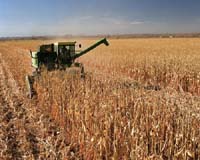 |
Thousand Oaks CA (SPX) May 22, 2009 Energy crop company Ceres has announced that switchgrass can produce substantially more biomass than previously reported and that average yields often used by academics and policymakers to forecast bioenergy economics and environmental benefits may, in fact, be far too conservative. The company reported that yield results from its nation-wide network of field trials showed that average biomass yields among switchgrass seed varieties tested last season were as much as 50% more than the government's projected yields for 2022. Proprietary varieties sold under the company's Blade Energy Crops brand were consistently the highest yielding varieties across multiple trial locations, with average yields reaching nearly 10 tons. The highest yield was reported in California, where a Ceres experimental variety produced 19 tons per acre. Ceres switchgrass product manager Cory Christensen, Ph.D., said that "this result demonstrates the genetic potential of switchgrass grown under favorable conditions." He predicted that "through trait development, better genetics and improved crop management practices, we can continue to increase average yields for many years to come." Christensen noted that higher yields per acre have a significant impact on farm and conversion economics, and can dramatically reduce harvest and delivery costs per ton, collectively the single largest expense in providing raw materials to bioenergy facilities. Similar benefits would be seen in calculating the greenhouse gas savings of displacing petroleum with biofuels made from dedicated energy crops. Based on the Ceres results, policymakers will likely need to re-think their assumptions regarding energy crop production. A number of studies assume yields as low as two to four tons per acre for switchgrass, and rather than incorporating yield increases from breeding, many of these studies hold yields virtually flat into the future. More recently, a highly regarded biofuel study co-authored by Sandia National Labs used a conservative six tons of biomass per acre for energy grasses - similar to estimates by the U.S. Environmental Protection Agency (EPA). Ceres chief executive Richard Hamilton says that Ceres needs additional data before formally proposing new benchmarks, but said the "writing was on the wall." Adding, "these results are not surprising when you look at the impact that utilizing modern biology has had on food crop yields, like corn, which has seen a five-fold increase since the first hybrids were introduced." Even using the government's conservative projections, switchgrass sequesters more carbon than any other raw material evaluated by EPA, which released its official analysis on advanced biofuels earlier this month. "Energy crops like switchgrass are the only scalable, carbon-negative sources for transportation fuels in the EPA analysis," Hamilton said, meaning that more carbon is sequestered from the atmosphere than is released in the lifecycle of producing and burning the fuel. "That's a benefit that electric cars, hydrogen and other renewables do not provide," he said. "With dedicated energy crops, increasing average on-farm yields will mean even greater gains in reducing greenhouse gases, as well as improved profitability for farmers and bioenergy companies. Perennial grasses are good and clearly can be made even better using well-proven technologies at hand today," Hamilton said. According to Ceres, the switchgrass data were collected from small-plot, replicated trials at locations across the mid and southern latitudes of the United States on both dry and irrigated land in 2008. Like other crops, biomass yields can vary among specific locations and year-to-year. Share This Article With Planet Earth
Related Links Ceres Bio Fuel Technology and Application News
 Plastic That Grows On Trees
Plastic That Grows On TreesRichland WA (SPX) May 22, 2009 Some researchers hope to turn plants into a renewable, nonpolluting replacement for crude oil. To achieve this, scientists have to learn how to convert plant biomass into a building block for plastics and fuels cheaply and efficiently. In new research, chemists have successfully converted cellulose - the most common plant carbohydrate - directly into the building block called HMF in one st ... read more |
|
| The content herein, unless otherwise known to be public domain, are Copyright 1995-2009 - SpaceDaily. AFP and UPI Wire Stories are copyright Agence France-Presse and United Press International. ESA Portal Reports are copyright European Space Agency. All NASA sourced material is public domain. Additional copyrights may apply in whole or part to other bona fide parties. Advertising does not imply endorsement,agreement or approval of any opinions, statements or information provided by SpaceDaily on any Web page published or hosted by SpaceDaily. Privacy Statement |